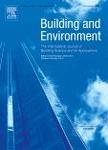版权所有:内蒙古大学图书馆 技术提供:维普资讯• 智图
内蒙古自治区呼和浩特市赛罕区大学西街235号 邮编: 010021

作者机构:Univ Pretoria Dept Mech Engn ZA-0002 Pretoria South Africa
出 版 物:《BUILDING AND ENVIRONMENT》 (建筑与环境)
年 卷 期:1999年第34卷第1期
页 面:19-30页
核心收录:
学科分类:0830[工学-环境科学与工程(可授工学、理学、农学学位)] 08[工学] 0813[工学-建筑学] 0814[工学-土木工程]
主 题:Heat transfer Heat conduction Matrix algebra Transfer functions Algorithms Fast Fourier transforms Frequency domain analysis Object oriented programming Two port envelope model Conduction transfer coefficients
摘 要:A zone envelope thermal model is derived from first principles, based on the exact two-port solution to the heat conduction equation. A single set of matrices, one for each frequency of interest, is used to describe the thermal behaviour of the total envelope. The set of matrices must be computed once for a particular zone and cooling loads for various conditions, or the passive response, can then be obtained. The method is based on the same principles underlying the CTF method. However, the transfer function is calculated for the whole envelope by combining the two-port matrices of the individual walls, after simplification of the room interior heat transfer network. The conduction transfer coefficients of the individual walls forming the zone are not required. Except for the simplification of interior radiation, the method is completely exact and easy to implement. It is also numerically efficient. For load prediction, an implementation in the frequency domain, based on the prime factor FFT algorithm is convenient. For time domain simulation with active control, the envelope conduction coefficients are easily obtained by transforming to the Z-domain. This represents a modern solution of the envelope conduction problem, which is convenient to implement in modern object oriented computer programming languages. 1998 Elsevier Science Ltd. All rights reserved.